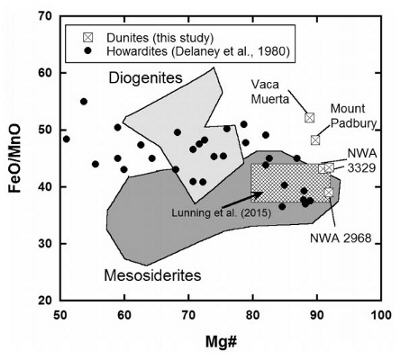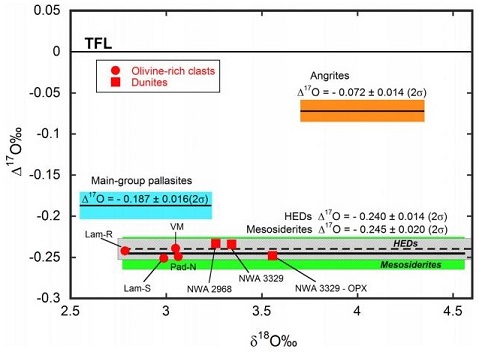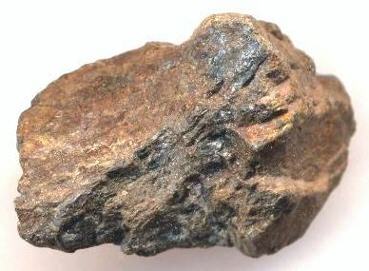NWA 2968
DiogeniteDiogenites belong to the evolved achondrite HED group that also includes howardites and eucrites. They are named after the Greek philosopher Diogenes of Apollonia, of the 5th century BCE, who was the first to suggest that meteorites come from outer space (a realization forgotten for over 2,000 years). They are Click on Term to Read More
Dunite
(UngroupedModifying term used to describe meteorites that are mineralogically and/or chemically unique and defy classification into the group or sub-group they most closely resemble. Some examples include Ungrouped Achondrite (achondrite-ung), Ungrouped Chondrite (chondrite-ung), Ungrouped Iron (iron-ung), and Ungrouped Carbonaceous (C-ung). Click on Term to Read More achondriteAn achondrite is a type of stony meteorite whose precursor was of chondritic origin and experienced metamorphic and igneous processes. They have a planetary or differentiated asteroidal origin where the chondritic parent body reached a sufficient size that through heating due to radioactive decay of 26Al (aluminum isotope) and gravitational Click on Term to Read More in MetBull 91)
Purchased November 2005
no coordinates recorded

Diagram credit: Greenwood et al., 2015
For an explanation of the diagram components see the open access article in GCA, vol. 169, p. 130 (2015)
‘GeochemistryStudy of the chemical composition of Earth and other planets, chemical processes and reactions that govern the composition of rocks and soils, and the cycles of matter and energy that transport Earth's chemical components in time and space. Click on Term to Read More and oxygenElement that makes up 20.95 vol. % of the Earth's atmosphere at ground level, 89 wt. % of seawater and 46.6 wt. % (94 vol. %) of Earth's crust. It appears to be the third most abundant element in the universe (after H and He), but has an abundance only Click on Term to Read More isotopeOne of two or more atoms with the same atomic number (Z), but different mass (A). For example, hydrogen has three isotopes: 1H, 2H (deuterium), and 3H (tritium). Different isotopes of a given element have different numbers of neutrons in the nucleus. Click on Term to Read More composition of main-group pallasites and olivine-rich clasts in mesosiderites:
Implications for the “Great Dunite Shortage ” and HED-mesosiderite connection’
(https://doi.org/10.1016/j.gca.2015.07.023)

Diagram credit: Greenwood et al., 2017
For an explanation of the diagram components see the open access article in Chemie der Erde – Geochemistry, vol. 77, p. 25 (2017)
‘Melting and differentiationA process by which a generally homogeneous chondritic body containing mostly metal, silicates and sulfides will melt and form distinct (differentiated) layers of different densities. When the melting process continues for a long enough period of time, the once chondritic body will re-partition into layers of different composition including Click on Term to Read More of early-formed asteroids: The perspective from high precision oxygen isotope studies’
(http://dx.doi.org/10.1016/j.chemer.2016.09.005) It is still unresolved whether such dunitic lithologies represent higher-level cumulates or if they are instead mantle material (Greenwood et al., 2015). Mandler and Elkins-Tanton (2013) proposed a formation scenario for such dunites that involves a two-stage crystallizationPhysical or chemical process or action that results in the formation of regularly-shaped, -sized, and -patterned solid forms known as crystals. Click on Term to Read More process: first, an equilibriumTerm used to describe physical or chemical stasis. Physical equilibrium may be divided into two types: static and dynamic. Static equilibrium occurs when the components of forces and torques acting in one direction are balanced by components of forces and torques acting in the opposite direction. A system in static Click on Term to Read More crystallization process from the late-stage liquid after 60–70% solidification of the global magma oceanCompletely molten surfaces of terrestrial planets or moons that formed soon after accretion. Samples returned by the Apollo missions provide evidence of a lunar magma ocean, crystallization of which produced a stratified Moon with a low-density crust formed by accumulation of the mineral plagioclase overlying a higher density mantle of Click on Term to Read More; second, a fractional crystallizationA crystallization process in which minerals crystallizing from a magma are isolated from contact with the liquid. It is a key process in the formation of igneous rocks during the process of magmatic differentiation. Also known as crystal fractionation. Click on Term to Read More process within an ascended, high-level (crustal) plutonGeology: Igneous intrusive body that forms when magma is injected into host rocks and solidifies. Plutons occur in the crust of asteroids undergoing differentiation or planets. Named after Pluto, the Roman god of the underworld. Plutonic rocks are the rocks found within a pluton. Astronomy: Category of planet including all Click on Term to Read More composed of the former extracted residual melt, ultimately resulting in the formation of a thin lower-crustal dunite layer along with more shallow olivine diogeniteDiogenites belong to the evolved achondrite HED group that also includes howardites and eucrites. They are named after the Greek philosopher Diogenes of Apollonia, of the 5th century BCE, who was the first to suggest that meteorites come from outer space (a realization forgotten for over 2,000 years). They are Click on Term to Read More, diogenite, and cumulate eucriteMost common type of achondrite meteorite and a member of the HED group. Eucrites are basalts composed primarily of pigeonite and anorthite (An60-98). Eucrites have been placed into three subgroups based on mineralogical and chemical differences. • Non-cumulate eucrites represent the upper crust that solidified on a magma ocean after Click on Term to Read More lithologies. On the other hand, if the dunitic clasts are actually derived from mantle material, a scenario is required to explain how such material was incorporated into the regolithMixture of unconsolidated rocky fragments, soil, dust and other fine granular particles blanketing the surface of a body lacking an atmosphere. Regolith is the product of "gardening" by repeated meteorite impacts, and thermal processes (such as repeated heating and cooling cycles). Click on Term to Read More. However, it was argued by Barrat and Yamaguchi (2014) that magmaMolten silicate (rock) beneath the surface of a planetary body or moon. When it reaches the surface, magma is called lava. Click on Term to Read More chamber processes are unable to explain the chemical diversity of the diogenites (e.g., the range of heavy-REE ratios in diogenitic orthopyroxenes), and that neither assimilation of wallrock nor incorporation of a trapped melt component can account for this diversity. They contend that the diversity is more likely the result of variability in the respective initial parental melt compositions. It is noteworthy that through continuing studies of MIL 03443, which is a cumulate, monomict, brecciated dunite previously classified as a mesosideriteOne of two main types of stony-iron meteorite, the other being pallasites. Mesosiderites are a mixture of approximately 50% basaltic, gabbroic and orthopyroxenitic silicates and 50% Ni-Fe metal and sulfides. The name derives from the Greek "mesos" meaning "middle" or "half" and "sideros" for "iron;" hence "half-iron". The silicates are Click on Term to Read More clastA mineral or rock fragment embedded in another rock. Click on Term to Read More, strong evidence has been developed for an origin on the HED parent body, and a relationship to diogenites specifically (Mittlefehldt, 2008; Beck et al., 2011). This evidence includes FeO/MnO and Δ17O values (see plot from Greenwood et al., 2015), the occurrence of olivine melt inclusions, and the abundances of pyrrhotite, Ni and Co. MIL 03443 has been shown to represent a fractional cumulate rather than a mantle restite (Beck et al., 2011). In a similar way, O-isotopic and trace elementSubstance composed of atoms, each of which has the same atomic number (Z) and chemical properties. The chemical properties of an element are determined by the arrangement of the electrons in the various shells (specified by their quantum number) that surround the nucleus. In a neutral atom, the number of Click on Term to Read More data for the unique 1.1 g olivine-rich (dunitic/harzburgitic?) achondrite QUE 93148 have led to the suggestion that it might be derived from the deep mantle of the HED parent body (Goodrich and Righter, 2000; C. Floss, 2003). However, due to its lower Co and Ni abundances than what would otherwise be expected for an olivine-rich mantle lithology or magma ocean cumulate, QUE 93148 could have actually originated on a distinct planetary body such as that of the main-group pallasites (Shearer et al., 2008; Shearer et al., 2010). Two other possible HED-related dunites, NWA 5784 and NWA 5968, will require further study to accurately assess their classification. Notably, Beck et al. (2012) identified the first olivine-rich melt material present in the howardites of the PCA 02009 pairing group. This olivine-rich material was likely derived from harzburgitic and dunitic lithologies exposed on the surface of Vesta. Further investigation employing the Antarctic DOM 10 howardite pairing group was conducted by Hahn et al. (2018). They sought to identify Mg-rich harzburgitic (distinguished from diogenitic) silicates (Mg# >80 and >85 for olivine and pyroxeneA class of silicate (SiO3) minerals that form a solid solution between iron and magnesium and can contain up to 50% calcium. Pyroxenes are important rock forming minerals and critical to understanding igneous processes. For more detailed information, please read the Pyroxene Group article found in the Meteoritics & Classification category. Click on Term to Read More, respectively) that represent HED mantle material. From results of a comprehensive geochemical analysis, they contend that these Mg-rich fragments are not related to cumulate diogenites, but instead are more consistent with a mantle residue that was affected by a late infiltration of metasomatic melt. In addition, they determined that QUE 93148 also likely represents a mantle residue from the HED parent body. The larger degree of partial meltingAn igneous process whereby rocks melt and the resulting magma is comprised of the remaining partially melted rock (sometimes called restite) and a liquid whose composition differs from the original rock. Partial melting occurs because nearly all rocks are made up of different minerals, each of which has a different melting Click on Term to Read More (~35–55%) required to produce the observed Mg-rich lithologies, considered to be mantle residua, is attributed by Hahn et al. (2018) to a hybrid magma ocean model that combines aspects of the magma ocean model of Mandler and Elkins-Tanton (2013) and the shallow magma ocean model of Neumann et al. (2014) (see diagrams B and D below).

click on diagrams for a magnified view Diagram credit: Hahn et al., MAPS, vol. 53, #3, p. 541 (2018)
‘Mg-rich harzburgites from Vesta: Mantle residua or cumulates from planetary differentiation?’
(http://dx.doi.org/10.1111/maps.13036) For further information about this dunitic meteorite and its potential pairing relationships see the NWA 3329 page. An alternative classification system for the diogenites based on mineralogical and petrographical features has been proposed by Beck and McSween (2010), and modified by Wittke et al. (2011). The photo shown above is a 5.8 g fragment of NWA 2968.







